The American diet, which tends to be less rich in fish consumption compared with Japan, China and almost any other country where fish is the major source of dietary protein, also tends to be low in omega fatty acids, says Sam Wright IV, chief executive officer of Crowley, La.-based The Wright Group.
In fact, average eicosapentaenoic acid (EPA) and docosahexaenoic acid (DHA) long-chain omega-3 fatty acid consumption in the United States is less than 185 mg a day, while health experts in various countries recommend 250-500 mg a day, says Lorin Debonte, assistant vice president of specialty seed and oil development at Minneapolis-based Cargill, citing data from the National Health and Nutrition Examination Survey.
According to Rockville, Md.-based Packaged Facts, an ideal intake ratio of omega-6 fatty acids, which are found in meat, poultry and eggs as well as corn, soybean and other seed oils, to omega-3 fatty acids, which are found in walnuts, certain seed oils, fatty fish, fish oils and algal oils, is between 1:1 and 4:1, but average American consumption tends to be between 10:1 and 20:1. This imbalance of anti-inflammatory omega-3s with pro-inflammatory omega-6 fatty acids has been tied to the development of various conditions and diseases, including cardiovascular disease, arthritis, eczema and Alzheimer’s disease, it states in its June 2011 report, “Omega-3 Foods and Beverages in the U.S., 3rd Edition.”
Deficiencies in omega-3 fatty acids also have been linked to decreased memory and mental abilities, tingling sensation of the nerves, poor vision, increased tendency of blood clots, diminished immune function, increased triglycerides and low density lipoprotein (LDL) levels, impaired membrane function, hypertension, arrhythmia, learning disorders, menopausal discomfort, and growth retardation in infants and children, Packaged Facts states in its report.
This consumer deficiency, combined with the fact that more than 40 percent of Americans either cannot or do not like to take pills, has given the beverage industry an opportunity to fulfill a consumer need, says Volker Berl, co-founder, chief operating officer and chief technology officer of Oceans Omega, a subsidiary of Paramus, N.J.-based Mycell Technologies.
The Wright Group’s Wright agrees, saying: “The beverage industry is proving to be a great vehicle for health and nutrition delivery. As companies fight the perception that carbonated beverages may be at the root of the obesity epidemic, companies are fighting back by adding nutrients to their products.”
From February 2012 to February 2013, more than
70 beverages containing omega fatty acids were launched globally, according to the Mintel Global New Products database. In addition, global consumer spending on EPA- and DHA-fortified products in the food and beverage, pet food, nutritional supplements, clinical nutrition, pharmaceutical and infant formula categories reached $25.4 billion in 2011, with North America accounting for 42.6 percent of these consumer sales, Packaged Facts states in its September 2012 report, “Global Market for EPA/DHA Omega-3 Products.” Although infant formula anchors the EPA and DHA market, accounting for 40 percent, fortified foods and beverages make up 31 percent, it adds.
Experts anticipate that the omega fatty acids market will only keep growing because of heightened consumer awareness and enhanced fortification technology. “Our expectation is that omega-3 fatty acids will be as common in beverages as vitamin C is today,” Oceans Omega’s Berl says. Packaged Facts projects that the value of EPA and DHA omega-3 packaged products will reach $34.7 billion in 2016, with sales in North America reaching $13 billion and global sales of fortified foods and beverages hitting $10.2 billion in that time frame.
Counting the omegas
Omega fatty acids are numbered by the position of the first double bond counting from the methyl side of the fatty acid chain, explains Ernesto Hernandez, Ph.D., director of process development for Omega Protein Corp., Houston. This means that omega-3 fatty acids have their first double bond on the carbon 3 atom, omega-6 on carbon 6 and so on, he says.
Omega-3 and omega-6 fatty acids are considered polyunsaturated fats, and some are essential fatty acids, because the human body cannot make them completely on its own and consumers need to obtain them from their diets, The Wright Group’s Wright says.
Some of the most commonly used omega-3s include alpha-linolenic acid (ALA), which is found in walnuts and flaxseed, soybean and canola oils; EPA, which is found in fatty fish and fish oils; and DHA, which is found in fatty fish and fish and algal oils, according to Cargill’s Debonte. Omega-3s from fish oil and microalgae are considered long-chain fatty acids, with EPA and DHA being the most bioactive of these, while omega-3s like ALA, which comes from non-marine sources, are short-chain fatty acids that are not as metabolically effective, Omega Protein’s Hernandez says.
According to The Wright Group's Wright, omega-3s often are referred to as a “Swiss Army” ingredient because of their many benefits. For instance, studies have shown that omega-3 aids in lowering cholesterol and blood pressure; preventing heart disease and macular degeneration; reducing the risk of stroke and certain cancers; controlling diabetes and inflammatory diseases; aiding in weight loss; and boosting calcium assimilation, skin healing and mental clarity, among other health benefits, Packaged Facts reports. In fact, because omega-3s are constantly being used by the body for these different benefits, it is difficult to consume too much of this type of fatty acid, it adds.
The cardiovascular and anti-inflammatory benefits of omega-3 fatty acids tend to attract baby boomer consumers, Omega Protein’s Hernandez notes. Additionally, mothers tend to be especially interested in ensuring that their infants and children consume enough omega-3s to gain the brain development benefits, The Wright Group’s Wright adds. Packaged Facts advises that beverage companies also can tap into the 20- to 40-year old demographic group by incorporating omega-3s into functional beverages, such as energy drinks and nutritional beverages.
Moderated levels of omega-6s have been shown in studies to lower blood cholesterol and support the skin, The Wright Group’s Wright says. However, an imbalance of omega-6s compared with omega-3s can interfere with the positive functions of omega-3s due to the structural similarities between the two types of fatty acids, Oceans Omega’s Berl adds.
Omega-9 fatty acid is a monounsaturated fat that is sometimes known as oleic acid, The Wright Group's Wright says. It is not considered an essential fatty acid because the human body can produce it in small amounts, he says. Like with omega-6s, an imbalance of omega-9s compared with omega-3s can interfere with omega-3s’ beneficial effects, according to Oceans Omega’s Berl.
Fishing for the right mix
Omega-3 fatty acids in the beverage market are predominantly found in refrigerated juices and milk products, Oceans Omega’s Berl explains. Omega-3s are inherently unstable to oxidation, and the colder temperatures of refrigeration slow down their rate of oxidation, he says. Plus, the closed containers also minimize the fatty acids’ exposure to air, further impeding decomposition, he adds.
However, as consumer awareness of the importance of omega-3 fatty acids increases, interest in the ingredient has expanded into other non-refrigerated beverage categories, Oceans Omega’s Berl says. To support omega-3 fatty acids’ growth, Oceans Omega has created stable, water-soluble liquid emulsions containing high concentrations of plant-derived and fish-derived omega-3 fatty acids for use in waters, seltzers, carbonated beverages, sports drinks and other clear beverages that will not affect the finished product’s taste, smell or texture, he says.
Taste has been another major hurdle in formulating beverages with omega fatty acids from fish oils, Omega Protein’s Hernandez says. Marine omega-3 oxidation in beverages can cause fishy odors, and improper stabilization can result in fishy tastes as well, according to experts. To overcome this challenge, Omega Protein refines, purifies and deodorizes its menhaden fish oils to produce an oil that is palatable to the consumer, Hernandez says.
Furthermore, beverage-makers can utilize microencapsulation formats to overcome the taste issue, The Wright Group's Wright notes. “Microencapsulation can improve taste and odor as well as prevent interactions with certain minerals [that] can cause rancidity, color problems and other concerns,” he says. For this purpose, The Wright Group offers microencapsulated omega-3 powders from fish and algal oils that “play well with others” for easy formulation, he adds.
Although marine sources of omega-3s tend to be more beneficial and metabolically effective than other types, these sources also can be more expensive, experts say. In February, DSM Nutritional Products, Heerlen, the Netherlands, announced a global pricing increase by a minimum of 15 percent for its fish-based omega-3 portfolio because of an all-time high trading price for crude fish oil, high sourcing costs, limited supply and high demand, the company says.
To offer a more cost-effective source of omega-3 fatty acids, Cargill partnered with BASF, Ludwigshafen, Germany, to work on developing canola varieties with EPA and DHA from canola seed oil, Cargill’s Debonte says. For the time being, Cargill also offers Clear Valley omega-3 oil, a canola-flax oil blend that acts as a source of ALA omega-3 essential fatty acid, he adds. Clear Valley is suitable for shelf-stable products and does not affect product taste, mouthfeel or shelf life, he says.
Plus, non-marine omega-3 sources, such as The Wright Group’s encapsulated omega-3 powders from vegetable sources, in addition to being cost-effective, can add the benefits of omega-3 to a beverage and appeal to vegetarian consumers, Wright says.
Once beverage-makers find the most stable, cost-effective omega-3 fatty acid mix for their beverages, they still face the challenge of presenting the health claims associated with the ingredient to consumers, Omega Protein’s Hernandez says. “Our government health institutions are slow in implementing [recommended dietary allowances] (RDAs) for omega-3s,” he says. “Most other countries from the developed world have some sort of dietary recommendations. … an RDA would make it easier to inform the consumer (on dosing, for example) and help provide clearer marketing guidelines to the manufacturer.”








